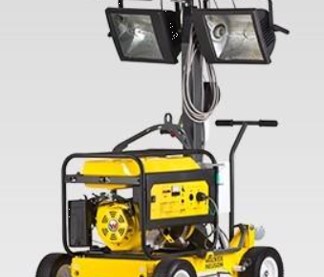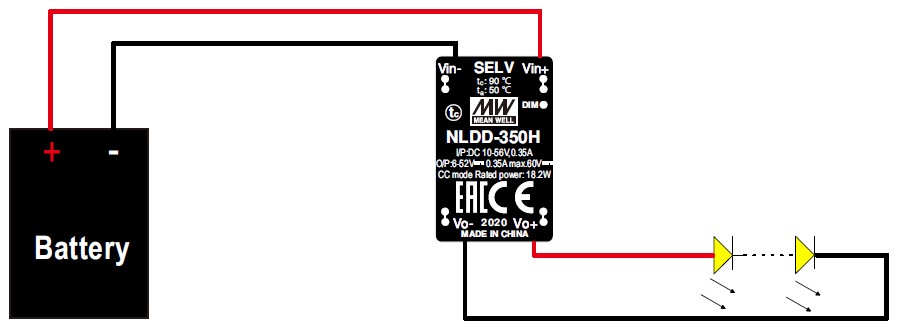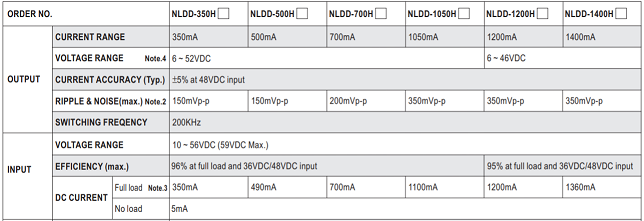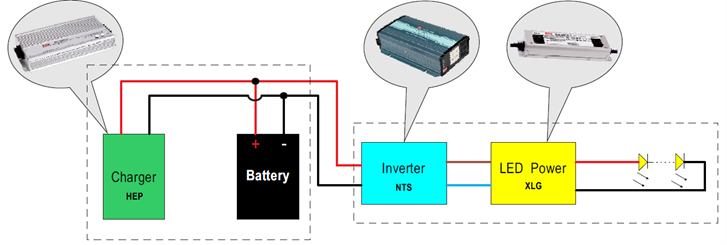Applications of portable lighting tower
By: Weiqiang Wu, Cunhui Wei /Technical Service Center
RMA@meanwell.com.cn
Portable lighting towers are suitable for all kinds of applications, mainly for outdoor usages, such as rescue mission and road repair mission, and the market has grown these years stably. As shown in Figure 1. the traditional portable lighting tower combined with a diesel generator provides electricity for the incandescent lamp mounted on the top. These traditional lighting towers have many disadvantages such as high power consumption, loud noise, pollution, high maintenance fee and heavyweight.

Fig 1. Traditional portable lighting tower that runs by generator
With the development and requirements of green energy, a new generation of environmentally friendly portable lighting towers has been widely used. Thanks to the advantages of small size, lightweight, sealed battery power supply, DC/DC LED driver, energy-saving and high efficiency. Places such as field training, construction operations, rescue mission, medical rescue, and television shooting are highly suitable for implementing LED lighting towers.
With the variety of portable LED lighting market demands, MEAN WELL announce the NLDD series to fulfil the need for a global trend of portable LED lighting application.
1 Portable lighting application:

Fig 2. Configuration of portable lighting application
Explanation of application:As shown in Figure 2. the portable lighting equipment composed of a battery and DC/DC LED driver. MEAN WELL NLDD-350H is design with a buck converter that provides a wide input DC range from 10V to 59V, which meets the 48V battery perfectly.
Specification of NLDD shown as follow.

2 Lifting portable lighting tower:

Fig 3. Configuration of lifting portable lighting tower
Explanation of application:
■As shown in Figure 3, it is a built-in charger with a lithium battery, inverter, LED driver and LED lamp for those portable lighting towers. HEP-1000 from MEAN WELL can modify the charging curve by SBP-001 (Figure 4) and satisfy different kinds of application for various battery.

Fig 4. HEP-1000 charging curve and configuration of SBP-001 programmer
■The new generation of portable lighting tower should equip AC output to fulfil all kinds of need when in an emergency. MEAN WELL have announced NTS-250~1200 High Reliable True Sine Wave DC-AC Power Inverter to meet the demand from the market.
【Selection of battery charger】
The voltage of a single battery cell is typically around 3.7V~4.2V. Take a 48V battery as an example; a 48V battery is made with 13 cells connected in series as shown in Figure 5, and the maximum charging voltage for each cell is 4.2V, leading the maximum charging voltage for the battery pack is 4.2Vx13=54.6V. Therefore, the charging voltage during the floating state should not exceed the parameter of 54.6V. HEP-1000 work together with SBP-001 comes in handy when modifying the charging parameter is needed.

Fig 5. Configuration of the battery pack
【Calculation of charging time】
Theoretically, the charging time of a battery is proportional to the capacity of the battery. But, resistance exists when charging the battery; therefore, the charging time typically will be 1.1~1.2 times comparing to the time in theory. We can conclude the estimation as follow.
Time of charging= 100Ah ÷17.5A×1.1≈6.3H
【Calculation of discharge time】
A battery of 100Ah with a 200W LED lamp,and the system consist of the XLG-240-H and the NTS-300 inverter.
Time of discharging= W/P *K= UI/P *K=(100A×1h×48V)÷(200W÷91%÷93%)×0.6≈12.2h
W total wattage of the load
P wattage of the load
K Discharging factor, use 0.6 in this case
91% is the efficiency of XLG-240-H
93% is the efficiency of NTS-300
If you have any problem of portable lighting application, please feel free to contact MEAN WELL technical service personnel.
